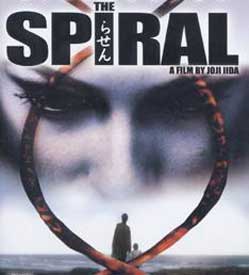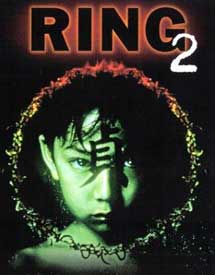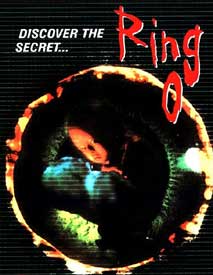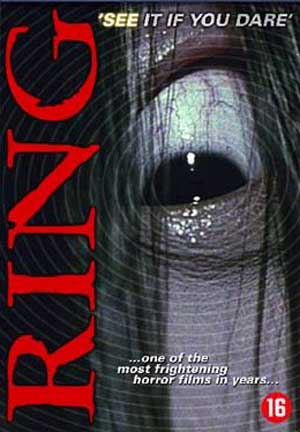Based on a novel by Koji Suzuki, Ringu became an international sensation even before it was refilmed in English. To some extent it revolutionized the nature of horror, by creating a franchise with multiple films in two languages all built more or less around the idea of a cursed video tape & its mysterious originator Sadako (Rie Inou), a betrayed girl who either always was or at least became a demoness when sealed alive in a well.
With disorienting surrealism Ringu legitimately undermines reality & reconstructs the world as thoroughly menacing. It never quite adds up to anything logical, but it carries a shocking conviction. It does not require ancient evil, but assumes the things of our modern age, such as a video tape & a telephone or a television screen, can be as cursed as any ancient relic.
It makes our world seem scary, which in fact it is. Most people watch horror because it is full of impossibilities & much more comforting than thinking about how easily we could ourselves get killed, whether in a hurricane or car accident. Ringu manages to bridge its impossibilities to the mundane world so it is emotionally a little harder to dismiss as a spook-house ride, even though of course it is a spook-house ride.
Reiko (Nanako Matsushima), a television newswoman (Nanako Matsushima), investigates the urban legend of a mysterious phenomenon that may be more than legend & may already have killed her niece. She acquires a copy of a video tape that apparently causes death one week after watching it. She is assisted by her ex-husband Takayama (Hiruki Sanada; he is a wonderful character actor, & star of Twilight Samurai). When they watch the cursed tape (itself arty & disturbing with a Luis Bunuel or Salvadore Dali feeling) their fates would seem to be sealed, as also that of their young son Yoichi (Takashi Yamamura), unless Yoichi's parents can resolve the mystery of the cursed tape's origin & lay the vengeful spirit to rest.
The viewer is tempted throughout by brief images Sadako as a well-ghost. We are eager to see more than is being revealed. Not until near the end does she become a wildly menacing presence above & beyond the existance of the cursed tape. I for one had my brain in full attention mode trying to follow the "explanations" for how Sadako -- abused in life because of her strangeness, & vengeful in death -- has been able to bring a cursed tape into existence. It never quite makes sense, but it is not difficult to just accept it as a given.
Several things beyond plain fine filmmaking make Ringu exceptional. First is the displacement of stock-figure psychopaths typical of "franchise" horror with a technological curse that makes the sound of a ringing phone or an unlabeled video tape seem menacing; this removes the film from everything that is old-hat. And second is the dark spirit of Sadako who lends herself to broad mythmaking, drawing less on western ideas of ghosts as it does upon Asian ideas of vengeful demonesses that had once been human. There's also the anassuming quality of the film, which requires no computerized FX to create disturbing images, both on the tape & for Sadako herself. The bigger budget English remake actually loses some of its power by being a bigger production.
It's not perfect. To some extent its imperfect perfection seems an accident more than it is the result of genius. Sometimes characters make leaps of logic that are not logical at all. They unravel the mystery of Sadako & find their way from place to place because the script says they do, not because their investigation leads them inexhoribly to these conclusions. But even the film's weaknesses become strengths; a slicker script with slicker production might've seemed merely manipulative rather than eerily disorienting.
Already so influential that Ringu has been much imitated, it has not to date lost any of its power to disturb. Films like Blair Witch or Matrix that were easy to imitate have swiftly become weaker films as they age because their visual surprises have become cliches as more & more films borrow images & camera angles until the originals begin themselves to look a little parodic. You gotta laugh at Matrix coats & Blair Witch facial lighting whether seen in imitative films or the originals. Something about Ringu remains its own, I suspect because it demands the intellect be at least marginally engaged to be spooked by it, & imitators can't rob the original of its smarts.
 Rasen (Spiral) furthers the mythology of Ringu, giving the mystery of the cursed video tape a science fiction turn. Much as optical data can be transferred between computers, the cursed tape brought into existence by the ghost of Sadako (Hinako Saeki) passes DNA instructions optically to the human brain, causing the recreation of an internal form of smallpox that causes throat boils & heart lesions resulting in death one week after viewing the tape. Rasen (Spiral) furthers the mythology of Ringu, giving the mystery of the cursed video tape a science fiction turn. Much as optical data can be transferred between computers, the cursed tape brought into existence by the ghost of Sadako (Hinako Saeki) passes DNA instructions optically to the human brain, causing the recreation of an internal form of smallpox that causes throat boils & heart lesions resulting in death one week after viewing the tape.
The first half to two-thirds of the film is extremely good. Ando, a depressed pathologist (Koichi Sato), is afflicted with suicidal thoughts due to the death of his son, when he encounters a victim of the cursed video, his fellow pathologist Takayama (Hiroyuki Sanada continuing his role from Ringu). He becomes involved with Takayama's girlfriend Mai (Miki Nakatani, who had a much smaller role in the first film) & gains a desire for life, but by then he has himself viewed the tape & believes he has only one week to live.
Perhaps a half hour before the end, the story goes all wacky in that Mai gives birth off-screen to the monstrous murder victim Sadako after Mai & the depressed doctor make love. The story is so nonsensical at this point it can barely explain itself, but essentially we're supposed to believe that the triggered virus that causes death has instead infected Ando's sperm with Sadako's DNA, & the disease leaves his body to be reborn from Mai. The infant grows to the age of its death within a week or so. All this we're told in a didactic manner, we don't see any of it happening.
(SPOILER ALERT!) Sadako kills Mai, but carries Mai's memories as well as her own, & is now played by the same actress who played Mai so that at first Ando doesn't know she's Sadako. It turns out that reborn Sadako represents a leap forward in evolution & if her ova are removed, fertilized with the DNA of anyone who has died (such as Ando's son, or Takayama) she can give birth to the dead who will instantly grow to the age they were when they died with all memories intact. That's it; that's the whole movie. Mai/Sadako gives birth to Mai's old lover Takayama & they live happily ever after. Mai/Sadako gives birth to Ando's son, & they live happily ever after. And Sadako will continue to spread the virus which will teach people fear, killing many, but other Sadako-types will also be created, & the nature of humanity will be changed. The end. (END SPOILER ALERT)
The bulk of the film about the cursed tape is as effective as Ringu & perhaps even better than Ringu. But the part of the film about rebirths through cloning is beyond ridiculous.
Still, it is slickly produced & very well acted, with the three main performers extremely appealing. One thing about casting in Japanese horror films, the male leads are nearly always unique in their beauty or appearance & can be great either as leading men or as character actors; but the female leads are interchangeable "basic" beauties akin to the interchangeable Barbi stars of so many American films. Not so for Rasen, as Miki Nakatani has an individualistic beauty to match that of her pair of leading men.
 Ringu was a great hit in Japan, but its sequel Rasen was a commercial & critical failure. Pretending the sequel Rasen had never been made, a completely different sequel to Ringu was concocted, doing away with the outre science fiction cloning & climax's absurd happy reunions in favor of the idea of a pure vengeful haunting. Ringu was a great hit in Japan, but its sequel Rasen was a commercial & critical failure. Pretending the sequel Rasen had never been made, a completely different sequel to Ringu was concocted, doing away with the outre science fiction cloning & climax's absurd happy reunions in favor of the idea of a pure vengeful haunting.
With some fudging it is just about possible to treat Ringu 2 as a prequel to Rasen & accept Rasen as part of the overall myth of the goblin Sadako, but mainly we have to dismiss Rasen & start over for Ringu 2. Curiously, the failed Rasen is truer to what the original author had written, but Ringu 2 although departing from the novel is truer to the tone & effectiveness of the original Ringu.
It takes up almost immediately after the events of Ringu without interruption. The sequel is not very stand-alone & might never make sense without refreshing one's memory with a re-viewing of Ringu. It is right off the bat established that Sadako (Rie Inou again) had managed to remain alive in the well for thirty years, not just a ghost but actually living, which is a pretty creepy part to her mythology. Through that period her psychic abilities turned into a fear-driven power of revenge with an existance of its own. Although Sadako did finally die & her body was recovered, the energy of her persists as an energy form or goblin that can record its essence on video tape.
The video tape is still being copied & passed about & people are still watching it & dying a week later. Mai Takano (again played by Miki Nakatani) is trying to find out what happened to the reporter Reiko (Nanako Matsushima) & her son Yoichi (Takashi Yamamura) after they viewed the cursed tape. The goblin Sadako had attempted in some vague way to possess or coopt the little boy to her vengeful scheme because he is himself a powerful psychic.
A disbelieving scientist attempts to impose scientific rationality on the events & finds a way of testing for the energy that is Sadako's vengeance, & he believes he can cause this energy to dissipate into water. But as it turns out science can't answer everything. At times I was reminded of how Exorcist II: The Heretic (1977) with its hoky "science" & its laughableness compared to the original, though Ringu 2 wasn't that bad.
The first hour of the film drags & the temptation to fast-forward is inescapable. When it at long last reaches the climactic final fourth of the film, it gets so "busy" with twists, action, & extra characters, that the effect is rather confused, & often corny. It definitely has eerie moments, & it's easy enough to care about the central characters, but it's not ultimately a good film.
Hiroyuki Sanada reprises his character of Takayama in flashbacks & as a ghost, but he's not much in the film, & the new leading man for the tale is a weak replacement. The story trundles out Takayama's ghost one last time in a heroic context to assist the heroine & the little boy in the well, but his appearance just adds to the muddle of the climax & doesn't really make any sense.
In general the writing & direction feels like an attempt to fool the viewer with its barrage of images & ideas & extra cast members & dizzying shifts of location, trying to disguise the fact that it doesn't really add up to much of anything. It has to be appreciated as a ride, not as a well constructed story, & in that regard it simply does not stand up to the power of the original.
 Ringu 0: Basudei (Ringu 0: Birthday) is a prequel to Ringu. It is not as effectively horrific as Ringu but it is more effective than either of the two sequels. It tells us a lot more about Sadako, who is hardly more than a monster in the other films, but becomes a character in her own right in the prequel. Ringu 0: Basudei (Ringu 0: Birthday) is a prequel to Ringu. It is not as effectively horrific as Ringu but it is more effective than either of the two sequels. It tells us a lot more about Sadako, who is hardly more than a monster in the other films, but becomes a character in her own right in the prequel.
Given how monstrous Sadako seemed to be in Ringu, it was a little odd that she was reborn in Rasen as something much less monstrous, finding love with the reborn Takayama. The prequel takes into consideration Rasen's tentative supposition that Sadako might not be totally monstrous (unlike the similar series about Tomie the relentlessly evil & continuously reborn girl goblin).
In Ringu 0 she is surprisingly sympathetic, so much so that when a troupe of actors come to believe they are all laboring under her curse, it is a little hard to believe they would blame her entirely & thus set out en masse to murder her. The whole idea that a troupe of actors could all of them so easily become murderers seemed to itself require a supernatural explanation that was not forthcoming.
In the course of the tale, Sadako's mysteriousness is revealed to be twofold, having good & evil components. These aspects manifest as two separate Sadakos who can apparently become a single being or project into each others' presence. The good Sadako is permitted to go out into the world where she suppresses remembrance of her twin & tries to live a normal life. Her evil twin is kept locked up. But since they are on some level one being that emanates from the haunted well, the evil twin is not really limited in her movements, & where the "good" Sadako goes the bad one is there too.
There seems not to be a total separation of the two Sadakos who are never quite shown in each others' presence, but sometimes she is a sweet girl afflicted by something outside herself, but having psychic powers including to heal by her touch. But just as suddenly fear can transform her into a destructive power, whether due to the influence of an evil twin or not is never really certain.
A lot of Japanese horror films are frustrating because of their lack of internal logic, but in the case of Ringu 0, as in the original Ringu, it actually benefits by keeping the possibilities vague; the mysteriousness is so much more fascinating than any explicit explanation of whether she is a ghost, a demoness, one person with projectable component, or two people psychically united. The problem with Rasen had been that it tried to provide too many explicit explanations, which turned out to be silly explanations, besides undermining Sadako's frightening & mysterious strangeness.
The last twenty minutes get brutal with some very horrific images both of the demonic form of Sadako, & of many terrible deaths. It is overall quite a good horror film.
copyright © by Paghat the Ratgirl
|



